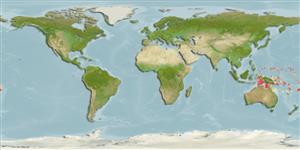>
Ovalentaria/misc (Various families in series Ovalentaria) >
Pomacentridae (Damselfishes) > Chrominae
Etymology: Chromis: Greek, chromis = a fish, perhaps a perch (Ref. 45335); earina: Name from Latinized form of the Greek adjective 'earinos' meaning 'the color of spring', which is green; referring to the pale green color of this species in life.
Environment: milieu / climate zone / Mức độ sâu / distribution range
Sinh thái học
Biển Cùng sống ở rạn san hô; Mức độ sâu 60 - 116 m (Ref. 59379). Tropical; 9°N - 21°S, 129°E - 178°W
Western Pacific: from Puluwat westward to Palau; south to Papua New Guinea, Vanuatu and Fiji; also Indonesia. It was not observed at Rarotonga (Cook Islands), Kiritimati (Line Islands), nor American Samoa during brief surveys of deep reefs at these localities.
Bộ gần gũi / Khối lượng (Trọng lượng) / Age
Chín muồi sinh dục: Lm ? range ? - ? cm
Max length : 6.6 cm SL con đực/không giới tính; (Ref. 59379)
Các tia vây lưng cứng (tổng cộng) : 12 - 13; Các vây lưng mềm (tổng cộng) : 11 - 12; Tia cứng vây hậu môn: 2; Tia mềm vây hậu môn: 12. This species is distinguished by the following characters: Dorsal rays XII-XIII, 11-12, usually XIII, 12; anal rays II, 12; pectoral rays 17-18, usually 18; spiniform caudal rays 3; tubed lateral-line scales 13-15, rarely 16; gill rakers 6-8 + 18-21 (total 26-28, rarely 25); body depth 1.65-1.9 in SL. The color when fresh is pale slate blue (bright pale green in life) with a white spot (sometimes two white spots) roughly the size of a scale mid-laterally on the body; malachite green area above orbit and in inter-orbital space and nape; the dorsal and anal fins with bright distal border of pale turquoise blue (Ref. 59379).
Body shape (shape guide): short and / or deep; Cross section: compressed.
Adults inhabit steep outer reef slopes and drop-offs with rocky outcrops and small caves and holes, often in association with limestone talus; usually observed in pairs or small groups, feeding low in the water column, and are generally abundant where they are found (Ref. 59379). Oviparous, distinct pairing during breeding (Ref. 205). Eggs are demersal and adhere to the substrate (Ref. 205). Males guard and aerate the eggs (Ref. 205).
Life cycle and mating behavior
Chín muồi sinh dục | Sự tái sinh sản | Đẻ trứng | Các trứng | Sự sinh sản | Ấu trùng
Oviparous, distinct pairing during breeding (Ref. 205). Eggs are demersal and adhere to the substrate (Ref. 205). Males guard and aerate the eggs (Ref. 205).
Pyle, R., J.L. Earle and B.D. Greene, 2008. Five new species of the damselfish genus Chromis (Perciformes: Labroidei: Pomacentridae) from deep coral reefs in the tropical western Pacific. Zootaxa 1671:3-31. (Ref. 59379)
IUCN Red List Status (Ref. 130435: Version 2025-1)
Threat to humans
Harmless
Human uses
Các công cụ
Special reports
Download XML
Các nguồn internet
Estimates based on models
Preferred temperature (Tài liệu tham khảo
123201): 25.6 - 27.6, mean 26.5 °C (based on 50 cells).
Phylogenetic diversity index (Tài liệu tham khảo
82804): PD
50 = 0.5000 [Uniqueness, from 0.5 = low to 2.0 = high].
Bayesian length-weight: a=0.01820 (0.00804 - 0.04119), b=2.99 (2.81 - 3.17), in cm total length, based on LWR estimates for this Genus-body shape (Ref.
93245).
Mức dinh dưỡng (Tài liệu tham khảo
69278): 3.0 ±0.1 se; based on size and trophs of closest relatives
Thích nghi nhanh (Tài liệu tham khảo
120179): Chiêù cao, thời gian nhân đôi của chủng quần tối thiểu là dưới 15 tháng (Preliminary K or Fecundity.).
Fishing Vulnerability (Ref.
59153): Low vulnerability (10 of 100).
🛈
